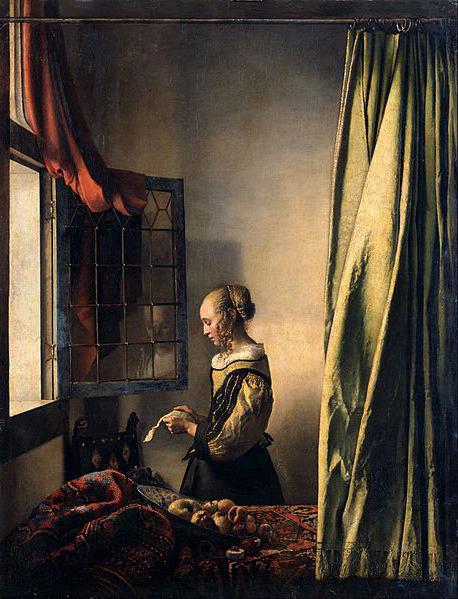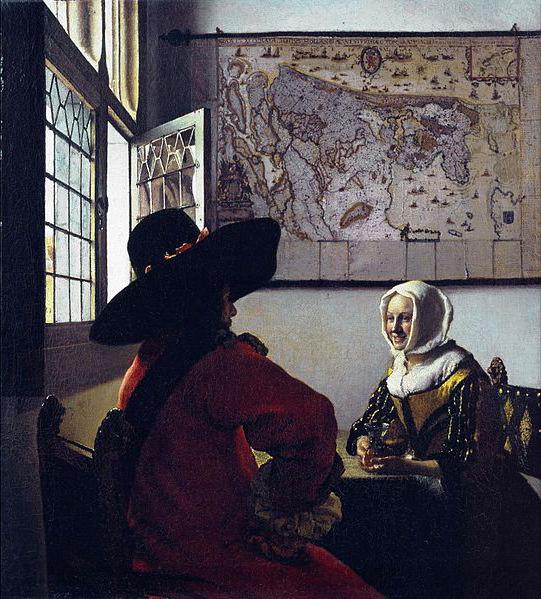Artist Jan Vermeer is one of the famous artists of the so-called Golden Age of Dutch fine art. He is considered an unsurpassed master of genre portraiture and household painting. His name is on a par with Frans Hals and Rembrandt. Since the place of birth and death of the artist is one town near the Hague, in the Russian tradition of art criticism he is called Jan Vermeer Delftsky. In this article we will consider the life and career of a painter.
Childhood and youth
The exact date of birth of the artist, we do not know. But he was baptized on the last day of October 1632 in one of the parish churches of Delft. Contrary to all ideas about large families of the time, Jan Vermeer’s father had, except his son, only a daughter. She was twelve years old at the time of her brother’s birth. About the master’s mother, Digne Baltes, we know almost nothing. Janson Rainer moved from Antwerp to Amsterdam in 1611 and was engaged in silk weaving. Already married, he migrated to Delft and bought an inn there. We do not know the reason, but for some reason he changed his last name and first name. The owner of the Mechelen Hotel was now called Reiner Van Vos. He did not abandon the weaving and enrolled in the Guild of St. Luke - a workshop that brought together all the artists. In this "union" in the twenty-first year of life, Vermeer Jan also entered, whose paintings shocked the world a few years later.
Education
One thing is clear: the son did not follow in the footsteps of his father and did not study silk weaving. Who did he take drawing lessons from? Indeed, in order to become a member of the guild of St. Luke, it was necessary to earn the title of master. And this, in turn, was preceded by at least six years of study and stay in the status of an apprentice. The record that Jan Vermeer Delftsky became a member of the guild dates back to the end of December 1653. So, he decided on a profession and began training as a teenager in his fifteenth year of life. Who was his teacher? Most art historians agree that it could be either Leonart Bramer or Gerard ter Borch. There is also a version that has not found documentary evidence that Karel Fabricius, a former student of Rembrant, helped Jan Vermeer to take the first steps in the visual arts. Unconditional influence on the young artist had Peter de Hooch. Vermeer inherited his style of genre painting in his canvases. But Hoh could not be a teacher of a young genius, since he lived in Delft only from 1652.
Personal life
While still a contender for the post of free master in the guild of St. Luke, Jan Vermeer married. Katerina Bolnes, the daughter of a successful entrepreneur who owns a brick kiln near Delft, became his chosen one. On the way to marriage, lovers were waiting for obstacles, but not of a material nature. The fact is that Jan Vermeer was from a Protestant family, and his bride was from a Catholic. The girl’s mother, Maria Bolnes, at first flatly refused the applicant to her daughter’s hand. It took the intercession of Bramer, also a Catholic, to soften the heart of the future mother-in-law. The wedding took place on April 20, 1653. Under the agreement, the newlyweds moved to the bride's house. But the artist continued to support his mother, who ran the hotel. Ian Vermeer and Katarina Bolnes gave birth to fifteen children, but only eleven survived their infancy. Artists of that time often depicted wives or lovers on their canvases. Vermeer Yang did not stand aside from this trend. The artist's paintings sometimes depict Katarina. For example, we can see her, pregnant, on the canvas "Woman with Weights."

Career
The artist's family was not poor. Initially, the Mechelen Hotel, located on the main market square of Delft, helped to feed a large family. Artists of the Netherlands are usually not in poverty. Paintings and objects of applied art were very popular in Dutch society. Masters of lesser talent made huge fortunes for themselves, painting several paintings a month. But Jan Vermeer did not like to rush. He painted two paintings throughout the year. Such slowness terribly annoyed his mother-in-law, but not patrons. They were ready to pay big money for his canvases. The main admirers of the master’s work were Hendrik van Buyten and Jacob Dissius, a baker and publisher of Delft. The fact that the painting of Jan Vermeer was appreciated by contemporaries is evidenced by the fact that the artist was twice elected dean of the guild of St. Luke (in 1662-1663, as well as 1670-1671).
last years of life
The master of genre painting was also appreciated as an art critic. This is the only trip to the city in Vermeer's life. He would never have left Delft if Frederick William I, Elector of Brandenburg, had not been offered to buy a collection of Roman and Venetian paintings. So the artist went as an expert to The Hague to verify the authenticity of the paintings. A notarial act has been preserved, which indicates that the masters Jordaens Jacob and Vermeer Jan paintings were considered not authentic and worth a tenth of the asking price. With such a favorite, the artist ended his days almost in poverty. In 1672, the Dutch-French war began, which lasted seven years. The art trade froze. Vermeer was forced to take loans to feed a large family. In 1675, the artist fell ill and died suddenly. All his inheritance went to creditors.
Vermeer Jan: early work
The young master was impressed by the Italian baroque for a long time. His early canvases are marked by the monumentality and elevation of images. The artist turns to religious topics ("Christ with Mary and her sister Martha"). The Dutch master of genre painting, Peter de Hooch, also exerts his influence. His style was continued and developed in the paintings of Vermeer. The most significant picture of this period can be called a large-figure canvas "At the shrine." It is believed that the character on the right is a self-portrait of the artist. The composition of the canvas “The Bulletin” is bright, full of youthful enthusiasm and sensuality. The tonal flavor is boldly combined with sonorous spots of pure color. Since the late 1650s, the artist changes the image. He writes small canvases with one or more characters and pays attention not so much to the plot as to the general mood and atmosphere of the scene. At the same time, he carefully writes out details, thinks through the lighting that transforms the interior of a small city room. Typical paintings for this period are “Girl with a Letter”, “Thrush”, “Lacemaker”.

Jan Vermeer: “Girl with a Pearl Earring”
This is the most famous painting by the artist. It belongs to the Hague Museum, but it can almost never be found on the spot - it travels around the world so often. And the girl depicted in the picture is often called the "Northern Mona Lisa." The master in this painting reached the peak of his genius. The young girl is like the personification of gentle femininity. The whole canvas is imbued with endless lyricism. Head turn with a defenseless look, pearl-blue colors of a scarf on a dark background, as it were, glow. Who did Jan Vermeer portray in the picture? A girl with a pearl earring ... It could be Maria, the artist’s eldest daughter. But, as opponents of this point of view assure, the first-born in the family appeared in 1653. Consequently, at the time of writing the picture (1665) Mary was only twelve. No matter how young the girl in the picture, she is still clearly older than the artist’s daughter.
Late canvases
At the end of the 60s of the seventeenth century, the artist changed his style a little. Now he has two favorite topics. These are gentlemen and ladies who conduct gallant conversations, savor wine or play music in richly decorated rooms. Examples include Love Letter and Young Woman with a Guitar. And the second topic is people who are passionate about their work. The inquiring mind of a person is depicted in the canvases "Astronomer", "Geographer", "In the artist's studio." The work and work of women is another topic that Vermeer Yang addresses at the end of his short life. The paintings “Lacemaker”, “Lady at the spinet”, “Woman in blue reading a letter” and “Girl trying on a necklace” are vivid examples of this period of the artist’s work.